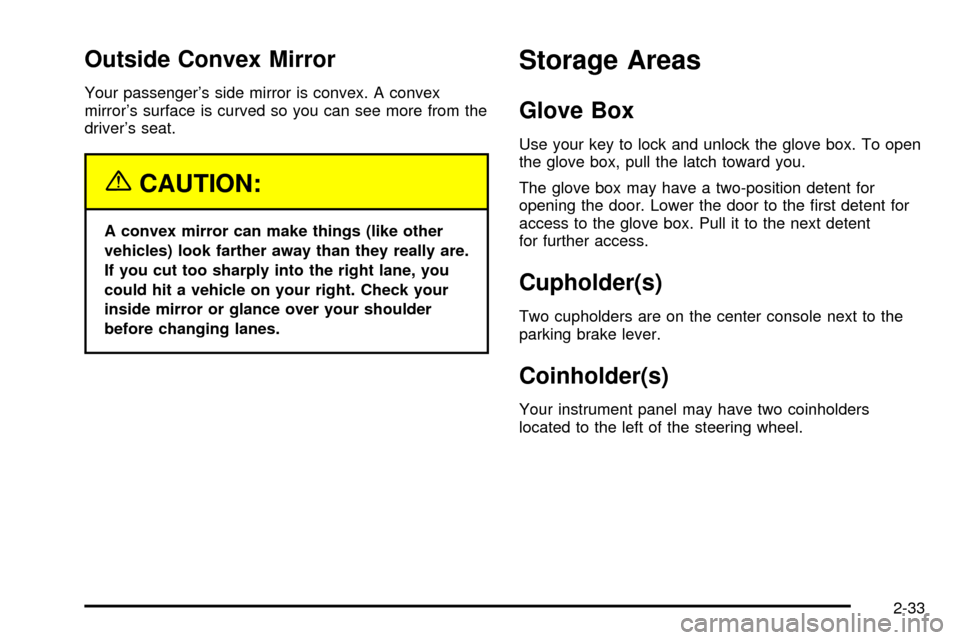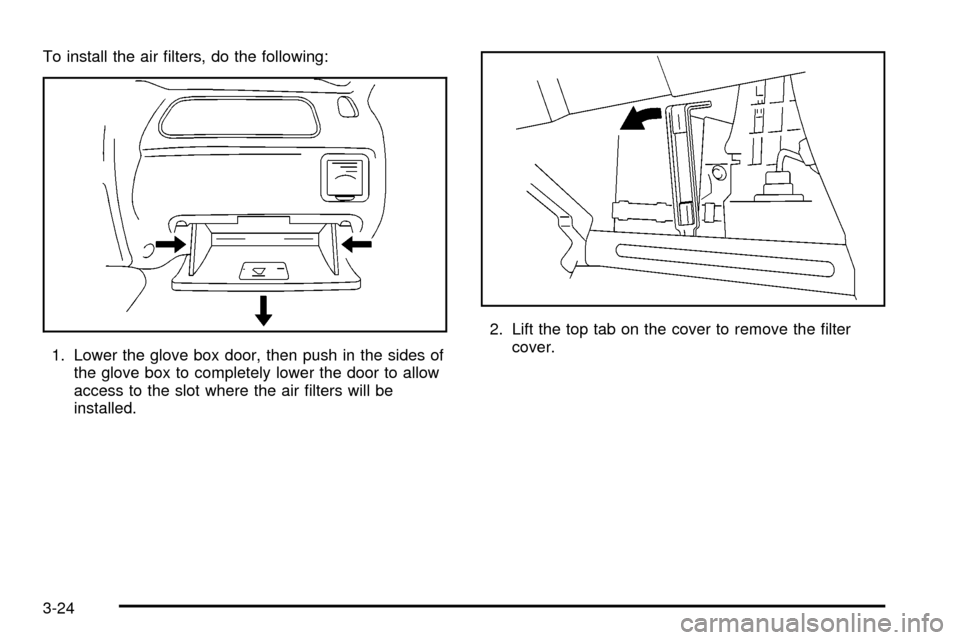glove box CHEVROLET TRACKER 2004 2.G Owners Manual
[x] Cancel search | Manufacturer: CHEVROLET, Model Year: 2004, Model line: TRACKER, Model: CHEVROLET TRACKER 2004 2.GPages: 374, PDF Size: 2.57 MB
Page 67 of 374

Keys...............................................................2-2
Remote Keyless Entry System.........................2-3
Remote Keyless Entry System Operation...........2-4
Doors and Locks.............................................2-6
Door Locks....................................................2-6
Power Door Locks..........................................2-7
Rear Door Security Locks................................2-8
Leaving Your Vehicle......................................2-9
Tailgate........................................................2-9
Windows........................................................2-10
Manual Windows..........................................2-11
Power Windows............................................2-11
Sun Visors...................................................2-11
Starting and Operating Your Vehicle................2-12
New Vehicle Break-In....................................2-12
Ignition Positions..........................................2-12
Starting Your Engine.....................................2-14
Engine Coolant Heater..................................2-15
Automatic Transmission Operation...................2-16
Manual Transmission Operation......................2-20Four-Wheel Drive..........................................2-22
Parking Brake..............................................2-24
Shifting Into Park (P).....................................2-25
Shifting Out of Park (P).................................2-27
Parking Your Vehicle.....................................2-28
Parking Over Things That Burn.......................2-28
Engine Exhaust............................................2-29
Running Your Engine While You Are Parked. . . .2-30
Mirrors...........................................................2-31
Manual Rearview Mirror.................................2-31
Outside Manual Mirrors..................................2-32
Outside Power Mirrors...................................2-32
Outside Convex Mirror...................................2-33
Storage Areas................................................2-33
Glove Box...................................................2-33
Cupholder(s)................................................2-33
Coinholder(s)................................................2-33
Luggage Carrier...........................................2-34
Convenience Net..........................................2-36
Cargo Cover................................................2-36
Section 2 Features and Controls
2-1
Page 99 of 374

Outside Convex Mirror
Your passenger's side mirror is convex. A convex
mirror's surface is curved so you can see more from the
driver's seat.
{CAUTION:
A convex mirror can make things (like other
vehicles) look farther away than they really are.
If you cut too sharply into the right lane, you
could hit a vehicle on your right. Check your
inside mirror or glance over your shoulder
before changing lanes.
Storage Areas
Glove Box
Use your key to lock and unlock the glove box. To open
the glove box, pull the latch toward you.
The glove box may have a two-position detent for
opening the door. Lower the door to the ®rst detent for
access to the glove box. Pull it to the next detent
for further access.
Cupholder(s)
Two cupholders are on the center console next to the
parking brake lever.
Coinholder(s)
Your instrument panel may have two coinholders
located to the left of the steering wheel.
2-33
Page 125 of 374

Operation Tips
·Clear away any ice, snow or leaves from the air
inlets at the base of the windshield that may
block the ¯ow of air into your vehicle.
·Use of non-GM approved hood de¯ectors may
adversely affect the performance of the system.
·Keep the path under the front seats clear of objects
to help circulate the air inside of your vehicle more
effectively.
·If the air¯ow seems low when the fan is at the
highest setting, the passenger compartment
air ®lters, if equipped, may need to be replaced. For
more information, see ªPassenger Compartment
Air Filterº following and
Short Trip/City Scheduled
Maintenance on page 6-7.
Passenger Compartment Air Filter
All models come equipped from the factory with a slot in
the ventilation system that is ready to accept passenger
compartment air ®lters. These ®lters are available for
purchase from your dealer. You will need to install
two ®lters to provide the proper ®ltration.
Both outside and recirculated air ¯ows through these
®lters and removes certain contaminates including pollen
and dust particles.
Reductions in air¯ow which occur more quickly in dusty
areas, may indicate that the ®lters need to be replaced
earlier than listed in the maintenance schedule. For how
often to replace your air ®lters, see
Maintenance
Requirements on page 6-2.
The access panel for the air ®lters is behind the
glove box.
3-23
Page 126 of 374

To install the air ®lters, do the following:
1. Lower the glove box door, then push in the sides of
the glove box to completely lower the door to allow
access to the slot where the air ®lters will be
installed.2. Lift the top tab on the cover to remove the ®lter
cover.
3-24
Page 305 of 374

Vehicle Identi®cation
Vehicle Identi®cation Number (VIN)
This is the legal identi®er for your vehicle. It appears on
a plate in the front corner of the instrument panel, on
the driver's side. You can see it if you look through the
windshield from outside your vehicle. The VIN also
appears on the Vehicle Certi®cation and Service Parts
labels and the certi®cates of title and registration.
Engine Identi®cation
The 8th character in your VIN is the engine code. This
code will help you identify your engine, speci®cations
and replacement parts.
Service Parts Identi®cation Label
You'll ®nd this label inside the glove box on the door. It's
very helpful if you ever need to order parts. On this
label is:
·your VIN,
·the model designation,
·paint information and
·a list of all production options and special
equipment.
Be sure that this label is not removed from the vehicle.
Electrical System
Add-On Electrical Equipment
Notice:Don't add anything electrical to your
vehicle unless you check with your dealer ®rst.
Some electrical equipment can damage your vehicle
and the damage wouldn't be covered by your
warranty. Some add-on electrical equipment can
keep other components from working as they
should.
Your vehicle has an air bag system. Before attempting
to add anything electrical to your vehicle, see
Servicing Your Air Bag-Equipped Vehicle on page 1-58.
5-93
Page 339 of 374

At Least Twice a Year
Restraint System Check
Make sure the safety belt reminder light and all your
belts, buckles, latch plates, retractors and anchorages
are working properly. Look for any other loose or
damaged safety belt system parts. If you see anything
that might keep a safety belt system from doing its
job, have it repaired. Have any torn or frayed safety belts
replaced.
Also look for any opened or broken air bag coverings,
and have them repaired or replaced. (The air bag
system does not need regular maintenance.)
Wiper Blade Check
Inspect wiper blades for wear or cracking. Replace
blade inserts that appear worn or damaged or that
streak or miss areas of the windshield. Also see
Cleaning the Outside of Your Vehicle on page 5-89.
Weatherstrip Lubrication
Silicone grease on weatherstrips will make them last
longer, seal better, and not stick or squeak. Apply
silicone grease with a clean cloth. During very cold,
damp weather more frequent application may be
required. See
Part D: Recommended Fluids and
Lubricants on page 6-30.
Fluid Level Check
Check the transfer case, axle differential(s) and
automatic or manual transmission ¯uid levels and add
as needed. See
Rear Axle on page 5-48,Four-Wheel
Drive on page 5-49, andAutomatic Transmission
Fluid on page 5-20orManual Transmission Fluid on
page 5-23. Check for leaks. A ¯uid loss in these systems
could indicate a problem. Have the system inspected
and repaired at once.
At Least Once a Year
Key Lock Cylinders Service
Lubricate the key lock cylinders with the lubricant
speci®ed in Part D.
Body Lubrication Service
Lubricate all body door hinges. Also lubricate all hinges
and latches, including those for the hood, rear
compartment, glove box door, console door and folding
seat hardware. Part D tells you what to use. More
frequent lubrication may be required when exposed to a
corrosive environment.
6-25
Page 366 of 374

Gasoline
Octane........................................................ 5-4
Speci®cations............................................... 5-4
Getting Familiar with Off-Road Driving................4-18
Glove Box.....................................................2-33
GM Mobility Program for Persons with
Disabilities.................................................... 7-5
H
Hazard Warning Flashers................................... 3-4
Head Restraints............................................... 1-5
Headlamp High/Low-Beam Changer.................... 3-7
Headlamps....................................................5-51
Bulb Replacement.......................................5-51
Front Turn Signal and Parking Lamps.............5-53
Halogen Bulbs............................................5-51
Sidemarker Lamps.......................................5-53
Headlamps On Reminder.................................3-15
Highway Hypnosis...........................................4-37
Hill and Mountain Roads..................................4-38
Hitches..........................................................4-60
Hood
Checking Things Under................................5-10
Release.....................................................5-10
Hood Latch Operation Check............................6-24
Horn............................................................... 3-5How to Add Coolant to the Coolant
Recovery Tank............................................5-33
How to Add Coolant to the Radiator..................5-35
How to Add Fluid....................................5-22, 5-24
How to Check................................5-20, 5-23, 5-64
How to Check and Add Fluid............................5-25
How to Check Lubricant...................................5-48
How to Check Power Steering Fluid..................5-37
How to Inspect the Engine Air Cleaner/Filter.......5-18
How to Use This Manual...................................... ii
How to Wear Safety Belts Properly...................1-14
Hydraulic Clutch.............................................5-24
Hydroplaning..................................................4-33
I
If No Steam Is Coming From Your Engine..........5-30
If Steam Is Coming From Your Engine...............5-29
If the Light Is Flashing.....................................3-34
If the Light Is On Steady.................................3-34
If You Are Caught in a Blizzard.........................4-42
If You Are Stuck in Sand, Mud, Ice or Snow.......4-44
If You Do Decide To Pull A Trailer.....................4-58
Ignition Positions.............................................2-12
Ignition Transmission Lock Check......................6-27
Infants and Young Children, Restraints...............1-31
In¯ation - Tire Pressure...................................5-63
6
Page 372 of 374

Shifting Out of Park (P)...................................2-27
Short Trip/City De®nition.................................... 6-5
Short Trip/City Intervals..................................... 6-5
Short Trip/City Scheduled Maintenance................ 6-7
Shoulder Belt Height Adjuster...........................1-17
Skidding........................................................4-15
Some Other Rainy Weather Tips.......................4-34
Special Fabric Cleaning Problems.....................5-87
Speci®cations, Capacities.................................5-98
Speedometer..................................................3-28
Stalling on an Incline.......................................4-27
Starter Switch Check.......................................6-26
Starting Your Engine.......................................2-14
Steering........................................................4-10
Steering in Emergencies..................................4-12
Steering, Suspension and Front Drive Axle Boot
and Seal Inspection.....................................6-28
Steering Tips..................................................4-10
Storage Areas
Coinholder(s)..............................................2-33
Convenience Net.........................................2-36
Cupholder(s)...............................................2-33
Glove Box..................................................2-33
Luggage Carrier..........................................2-34
Storing a Flat or Spare Tire and Tools...............5-84
Stuck in Sand, Mud, Ice or Snow......................4-44
Sun Visors.....................................................2-11
Supplemental Restraint System (SRS)...............1-52
Adding Equipment to Your Air Bag-Equipped
Vehicle...................................................1-59Supplemental Restraint System (SRS) (cont.)
How Does an Air Bag Restrain?....................1-56
Servicing Your Air Bag-Equipped Vehicle.........1-58
What Makes an Air Bag In¯ate?....................1-55
What Will You See After an Air Bag
In¯ates?..................................................1-56
When Should an Air Bag In¯ate?...................1-55
Where Are the Air Bags?..............................1-54
T
Tachometer....................................................3-28
Tailgate........................................................... 2-9
Tailgate Lock Release....................................... 2-9
Throttle System Inspection...............................6-29
Tilt Wheel........................................................ 3-5
Tire In¯ation Check.........................................6-24
Tire Sidewall Labeling......................................5-56
Tire Size.......................................................5-59
Tire Terminology and De®nitions........................5-60
Tires.............................................................5-55
Buying New Tires........................................5-67
Chains.......................................................5-71
Changing a Flat Tire....................................5-72
If a Tire Goes Flat.......................................5-72
In¯ation - Tire Pressure................................5-63
Inspection and Rotation................................5-64
Uniform Tire Quality Grading.........................5-68
Wheel Alignment and Tire Balance.................5-69
12